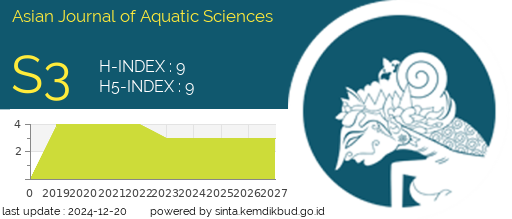SCREENING THE ANTIBACTERIAL POTENTIAL OF Avicennia marina MANGROVE LEAF EXTRACT AS A NATURAL ANTIBIOTIC INGREDIENT
DOI:
https://doi.org/10.31258/ajoas.7.3.462-469Keywords:
Antibiotics, Aeromonas hydrophila, Avicennia marina, Bacterial ResistanceAbstract
Bacterial resistance to antibiotics is a global health problem caused by two factors, namely natural resistance and acquired resistance. Several factors can cause problems. The problem in this research is whether Avicennia marina mangrove leaf extract found in the mangrove ecosystem in Bandar Bakau, Pangkalan Sesai Village, Dumai City, can be used as an antibiotic. This research was conducted in January-March 2024. This research aimed to determine the potential of mangrove leaf extract A. marina as an antibiotic against pathogenic bacteria Vibrio sp, Aeromonas sp, and Pseudomonas sp. The results of this research will provide benefits in the form of information regarding the potential of A. marina mangrove leaf extract as an antibiotic. The methods used in this research are survey methods and experimental methods. The samples were then analyzed using the paper disk diffusion method at the Marine Microbiology Laboratory, Faculty of Fisheries and Marine Science, Universitas Riau. The data obtained is then presented and explained descriptively. The research results showed that antibiotics added to A. marina leaf extract could inhibit the growth of A.hydrophila bacteria based on the inhibition zone formed of 11mm. A.marina contains alkaloids, terpenoids, and flavonoids and has antibacterial properties against A.hydrophila bacteria. Based on the data, it can be concluded that A.marina leaf extract can be used against pathogenic bacteria
Downloads
References
1. Afzal, M., Masood, R., Jan, G., Majid, A., Fiaz, M., Shah, A. H., Alam, J., Mehdi, F.S., Abbasi, F.M., Ahmad, H., Islam, M., Inamullah., & Amin, N.U. Efficacy of Avicennia marina (Forsk.) Vierh. Leaves Extracts againts Some Atmospheric Fungi. African Journal of Biotechnology, 2011; 10(52): 10790- 10794.
2. Aini, R. Identifikasi Keanekaragaman Pohon Mangrove di Kawasan Wisata Hutan Mangrove Teluk Benoa Bali sebagai Dasar Pembuatan Sumber Belajar Biologi. Universitas Muhammadiyah Malang. Malang, 2017
3. Anggraini, R.R., Hendri, M., & Rozirwan, R. Potensi Larutan Bubuk Daun Mangrove Bruguiera gymnorrhiza sebagai Pengawet Alami. Maspari Journal, 2018; 10(1): 51-62.
4. Pramanayudha, G., Khotimah, S., & Rahmayanti, S. Uji Aktivitas Senyawa Kitoson terhadap Neisseria gonorrhoeae yang Diisolasi dari Pasien dengan Penyakit Infeksi Seksual secara in Vitro. Jurnal Mahasiswa PSPD FK Universitas Tanjungpura, 2018; 4(3).
5. Dari, D.W., & Junita, D. Karakteristik Fisik & Sensori Minuman Sari Buah Pedada. Jurnal Pengolahan Hasil Perikanan Indonesia, 2020; 23(3): 532541.
6. Pelezar, J.M., & Chan, E.C.S. Dasar-Dasar Mikrobiologi Jilid I. Universitas Indonesia. Jakarta, 2008; 954-955.
7. Usman, U. Uji Fitokimia dan Uji Antibakteri dari Akar Mangrove Rhizopora apiculata terhadap Bakteri Escherichia coli dan Staphylococcus aureus. Jurnal Kimia dan Pendidikan, 2017; 2(3): 169 – 177.
8. Syawal, H., Hakim, L., & Effendi, I. Phytochemical Analysis of Rhizopora apiculata Leaf Extract and Its Inhibitory Action against Staphylococcus aureus, Aeromonas hydrophila and Pseudomonas aeruginosa. Aquaculture, Aquarium, Conservation & Legislation, 2020; 13(4): 2242 - 2249.
9. Nopiyanti, H.T., Fitriani, A., Isnaini, I., & Melki, M. Screening of Nypa fructions as Antibacterial of Bacillus subtillis, E.coli and S. Aureus. Jurnal Maspori, 2016; 8(2): 83-90.
10. Hendrawan, H., Zuraida, I., & Pamungkas, B.F. Aktivitas Antibakteri Ekstrak Methanol Xylocarpus granatum dari Pesisir Muara Badak. Jurnal Perikanan Tropis, 2015; 20(2): 253- 259.
11. Panjaitan, R.S., Warganegara, W., & Madayani, F. Aktivitas Antibakteri Ekstrak Lipid Sargassaum polycistum terhadap Bacillus cereus dan Staphylococcus aureus. Jurnal Kimia dan Pendidikan, 2017; 3(3): 29-39.
12. Gabariel, E., Yoswaty, D., & Nursyirwani, N. Inhibition of Xylocarpus granatum extract against the Growth of Pathogenic Bacteria (Pseudomonas aeruginosa, Escherichia coli, and Vibrio alginolyticus). Jurnal Perikanan dan Kelautan, 2019; 24(2):114-118
13. Egra, S., Mardhiana, M., Roffin, M., Adiwena, M., Jannah, N., Kuspradini, H., & Mitsunaga, T. Aktivitas Antimikroba Ekstrak Bakau (Rhizophora mucronata) dalam Menghambat Pertumbuhan Ralstonia solanacearum Penyebab Penyakit Layu. Agrovigor: Jurnal Agroekoteknologi, 2019; 12(1): 26- 31.
14. Devi, S., & Mulyani, T. Uji Aktivitas Antibakteri Ekstrak Etanol Daun Pacar Kuku (Lawsonia inermis Linn) pada Bakteri Pseudomonas aeruginosa. Journal of Current Pharmaceutical Sciences, 2017;1(1): 30- 35.
15. Suciari, L.K., Mastra, N., & Widya, C.D. Perbedaan Zona Hambat Pertumbuhan Staphylococcus aureus Pada Berbagai Konsentrasi Rebusan Daun Salam (Syzygium polyanthum) secara In Vitro. Meditory, 2017; 5(2): 92-100








